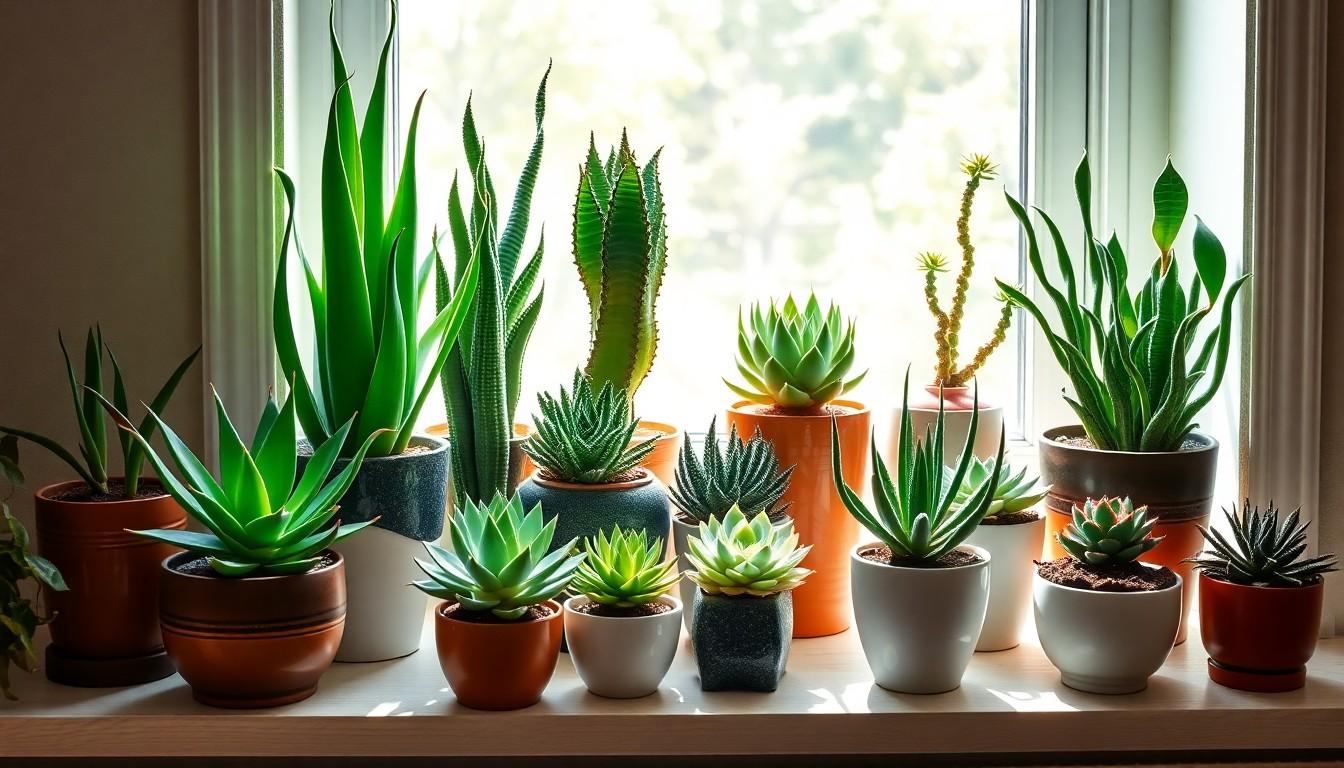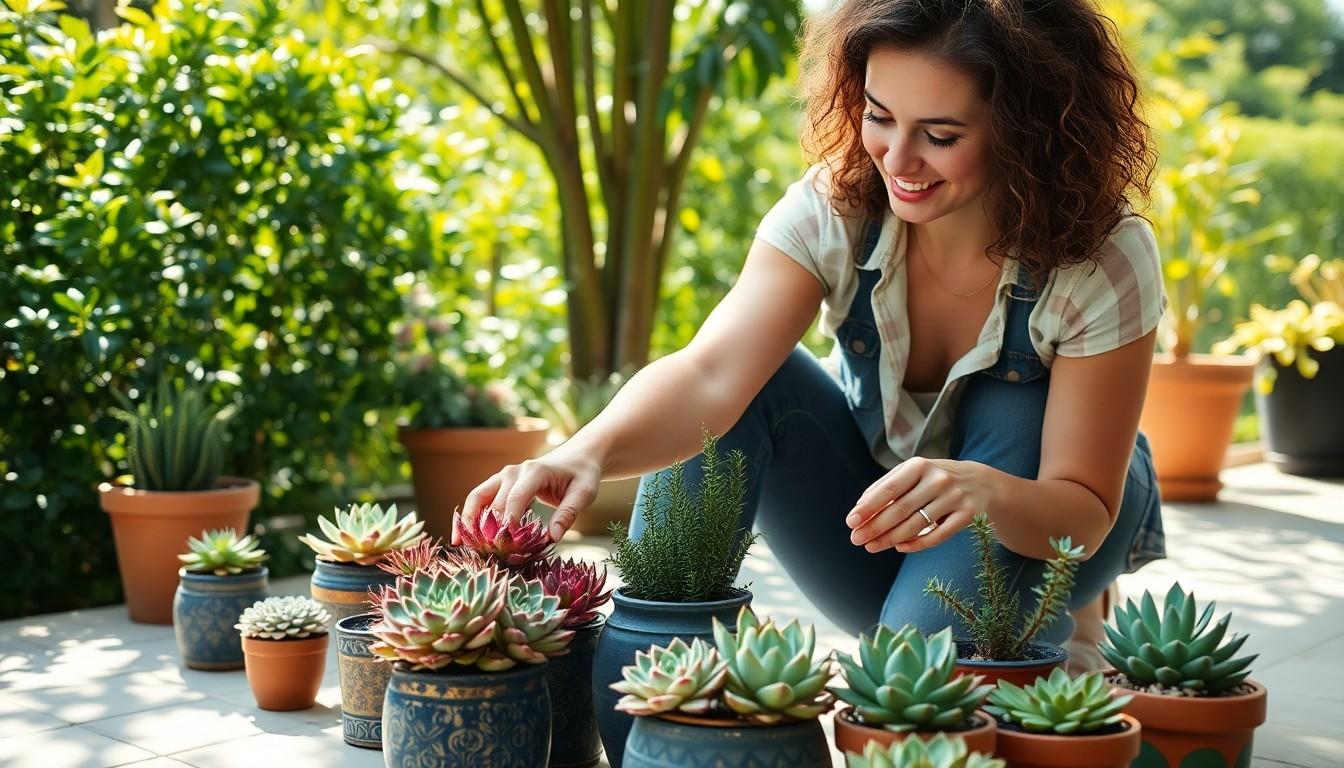Succulents are the rock stars of the plant world—low maintenance and endlessly charming. If you’ve ever wanted to add a touch of greenery to your home without the fuss of a diva plant, succulents are your go-to. These little gems thrive on neglect and bring a pop of personality to any space. Plus, they’re the perfect excuse to show off your gardening skills without needing a PhD in botany.
Understanding Succulents
Succulents encompass a diverse group of plants known for their thick, fleshy tissues. These adaptations enable them to store water, making them suitable for arid environments.
What Are Succulents?
Succulents include species from various plant families, such as cacti and euphorbias. Plants recognized as succulents possess specialized structures to retain moisture. Common types include aloe vera, jade plants, and haworthia. Many people appreciate succulents for their unique shapes and colors, making them attractive for indoor and outdoor decor.
Benefits of Growing Succulents
Growing succulents offers numerous advantages. Low maintenance needs suit busy schedules, reducing the time spent on plant care. Watering requirements often consist of infrequent drinks, contributing to their resilience. Their ability to thrive in limited light levels makes them ideal for various indoor spaces. Additionally, succulents help purify the air, enhancing indoor environments.
Choosing the Right Succulents

Selecting appropriate succulents sets the foundation for successful growth. Various factors influence this choice.
Popular Succulent Varieties for Beginners
Aloe vera stands out as a popular choice for its health benefits and ease of care. Echeveria, with its rosette shape and vibrant colors, appeals to many gardeners. Jade plants symbolize good luck and thrive with minimal attention. Haworthia pairs well with other plants due to its stunning appearance and tolerance for low light. These varieties provide a great starting point for novices and offer opportunities for experimentation.
Factors to Consider When Selecting Succulents
Climate plays a significant role in succulent selection, as certain species thrive in specific environments. Light conditions in the home should align with the plant’s needs; some prefer bright light, while others adapt to low light. Pot size affects growth; adequate space encourages healthy root development. Growing medium is essential; well-draining soil prevents root rot. Assessing space availability ensures the selected varieties fit comfortably without overcrowding.
Preparing for Planting
Preparing for planting succulents involves gathering the right tools and materials as well as selecting suitable soil to ensure optimal growth.
Required Tools and Materials
Gather essential tools and materials before starting. Use a pair of gloves to protect hands from dirt. Select pots with drainage holes to prevent waterlogging. Keep a trowel handy for easy handling of the soil. A watering can with a narrow spout offers precise watering. Consider using a spray bottle for misting to maintain humidity levels. Finally, obtain labels to identify different succulent varieties.
Choosing the Right Soil
Choosing the right soil significantly impacts succulent health. Opt for a well-draining mix specifically formulated for cacti and succulents. This mix typically contains components like coarse sand, pumice, and perlite. Ensure the soil allows adequate airflow to the roots, preventing root rot. Avoid regular potting soil as it retains too much moisture. Test the soil’s drainage by pouring water through; it should flow freely without pooling.
Planting Succulents
Planting succulents involves several key steps to ensure they thrive in their new environment. Preparing the right materials and following a methodical approach promotes healthy growth.
Step-by-Step Planting Guide
- Choose a pot with drainage holes to prevent water accumulation.
- Fill the bottom with coarse gravel for improved drainage.
- Add a well-draining soil mix formulated for cacti and succulents.
- Remove the succulent from its nursery container carefully.
- Create a small hole in the soil and place the plant inside, ensuring the roots are spread out.
- Cover the roots with soil, leaving the base of the plant exposed.
- Water lightly to settle the soil, avoiding excess moisture.
Tips for Successful Planting
Ensure the pot is at least 2 inches wider than the root ball for optimal growth. Use gloves while handling succulents to protect delicate leaves. Monitor light conditions and place the pot in an area with indirect sunlight initially. Adjust the watering schedule based on the season; succulents need less water in winter. Mist the plant occasionally to enhance humidity, particularly in dry environments.
Caring for Your Succulents
Caring for succulents involves understanding their specific needs to promote healthy growth. Proper watering and light exposure greatly enhance their longevity and vibrancy.
Watering Techniques
Watering techniques play a crucial role in succulent care. Allowing the soil to dry out completely between waterings prevents root rot. During the growing season, water every two to three weeks, while in winter, reduce frequency to once a month. Pour water directly onto the soil, avoiding contact with the leaves to prevent fungal issues. Observing the plant’s appearance helps determine if adjustments are necessary; if leaves appear wrinkled, increase watering slightly. Conversely, if leaves become mushy, cut back on the water.
Light and Temperature Requirements
Light and temperature requirements significantly impact succulent health. Most succulents thrive in bright, indirect sunlight for six hours daily. Placing them near south or west-facing windows offers the best exposure. They tolerate partial shade, but insufficient light leads to leggy growth. Temperatures between 60°F and 80°F suit most varieties, yet many handle occasional drops to 40°F. Protecting succulents during extreme temperature changes ensures optimal growth; consider moving them indoors when cold weather strikes. Enduring direct, scorching sunlight can lead to sunburn, so take precautions to avoid such damage.
Common Challenges and Solutions
Succulents can thrive in various conditions, but challenges may arise. Recognizing potential problems early helps maintain their health.
Recognizing Signs of Overwatering
Signs of overwatering often manifest through yellowing leaves. When leaves become mushy, it indicates excessive moisture. Additionally, a foul odor from the soil suggests root rot has begun. In cases like these, reducing watering frequency proves essential. Adjusting the watering routine to allow the soil to dry out completely promotes recovery. Using well-draining soil can also help prevent future issues. Moreover, it’s vital to choose pots with drainage holes to facilitate moisture escape.
Pest Management Strategies
Pests such as mealybugs and aphids can threaten succulent health. Regular inspections help catch infestations early. A solution involves wiping affected areas with a cotton swab dipped in alcohol, effectively eliminating pests. Neem oil serves as an organic alternative for treatment, providing protection while being gentle on plants. Maintaining good air circulation around succulents minimizes pest attraction. Keeping plants clean and removing debris contributes to overall health. Finally, separating infested plants helps prevent the spread to healthy succulents.
Conclusion
Starting a succulent garden can be a rewarding experience. With their low maintenance needs and unique beauty, succulents make it easy for anyone to enjoy the joys of gardening. By selecting the right varieties and providing the proper care, even beginners can cultivate a thriving collection.
It’s essential to remember the importance of light conditions and watering practices for optimal growth. Regular monitoring and adjustments will help prevent common issues and ensure the plants flourish. With a bit of patience and experimentation, anyone can create a stunning display of these resilient plants in their home. Embrace the journey and watch as your succulents thrive.

